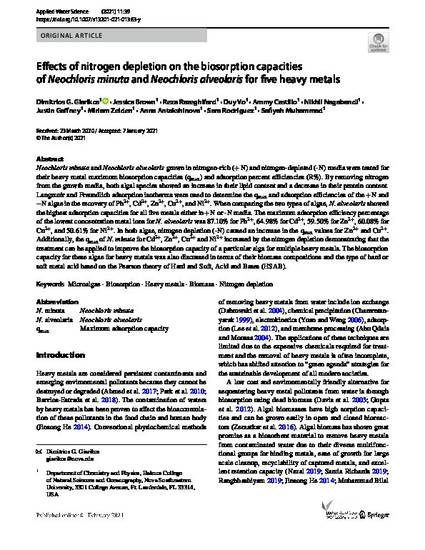
- Microalgae,
- Biosorption,
- Heavy metals,
- Biomass,
- Nitrogen depletion,
- SECLER
Neochloris minuta and Neochloris alveolaris grown in nitrogen-rich (+ N) and nitrogen-depleted (-N) media were tested for their heavy metal maximum biosorption capacities (qmax) and adsorption percent efficiencies (R%). By removing nitrogen from the growth media, both algal species showed an increase in their lipid content and a decrease in their protein content. Langmuir and Freundlich adsorption isotherms were used to determine the qmax and adsorption efficiencies of the + N and −N algae in the recovery of Pb2+, Cd2+, Zn2+, Cu2+, and Ni2+. When comparing the two types of algae, N. alveolaris showed the highest adsorption capacities for all five metals either in + N or -N media. The maximum adsorption efficiency percentage of the lowest concentration metal ions for N. alveolaris was 87.10% for Pb2+, 64.98% for Cd2+, 59.50% for Zn2+, 60.08% for Cu2+, and 50.61% for Ni2+. In both algae, nitrogen depletion (-N) caused an increase in the qmax values for Zn2+ and Cu2+. Additionally, the qmax of N. minuta for Cd2+, Zn2+, Cu2+ and Ni2+ increased by the nitrogen depletion demonstrating that the treatment can be applied to improve the biosorption capacity of a particular alga for multiple heavy metals. The biosorption capacity for these algae for heavy metals was also discussed in terms of their biomass compositions and the type of hard or soft metal acid based on the Pearson theory of Hard and Soft, Acid and Bases (HSAB).
Available at: http://works.bepress.com/reza-razeghifard/14/
